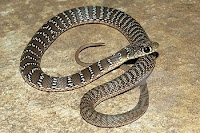
Indian Rat Snake
(Ptyas Mucosa)
- General Information: Snakes fascinate us more then any other creature on earth. Because people don't know much about then, snakes are misunderstood and feared. In India most of our snakes are absolutely harmless to humans while only four species are responsible for thousands of deaths each year.Indian snakes range in size from a few centimeters to almost ten meters in length. Snakes live in scorching deserts, humid forests, cool hill ranges, in lakes, streams, and even in the sea. The variety of colors and patterns rivals the butterflies while their grace and fluidity are unmatched in nature. Snake behaviour and adaptations are endlessly exciting but the first step is to be able to identify them. So let us get a bit close to them. Let us get a little friendly with such fascinating creature.
Scalation of Indian Rat Snake

- Description: Rat snakes are non venomous. They are large, fast moving snakes which grow to a length of 2 ½ meters or more. Color varies from pale yellow, olive, brown, gray or black. There body is lightly or strongly marked with black; Marking usually distinct on tail. Lip scales usually separated by vertical black lines. Underside often has prominent dark cross-bars. Scales smooth or keeled (upper rows). Head is broader then neck. Large eye has round pupil. Rat snakes are found wherever rats and frogs/toads are prevalent. So, of course, they are often found in rice fields and in human habitation. As hill forests are cleared and agriculture spreads to the slopes, rat snakes too are spreading "upwards". Recent records say that they are found 2,000 meters up in plains. Formerly they were rarely seen above 1,000 meters.The rat snake is active during the day, hunting for rodents, frogs, toads and birds along fields and in bushes. Large rat snakes can give a painful bite and are quick to defend themselves.
- Reproduction: The female lays about 8 to 16 eggs. At hatching young sizes between 320 - 470mm (13 - 19 inc.). Young ones start on hatching start their diet on frogs and toads. During a breeding season, a male rat snakes perform a combat dance. This is actually their way of protecting the area they live in and preventing other male snakes from entering their territory. This dance has nothing to do with mating as people claim.
- Distribution: This snake inhabits a wide range of habitats - coastal, arid, wet, mountainous, open fields as well as forests. Found throughout South and Southeast Asia, from Sea level to 4000m (13,120ft).
- Look - alikes: Indian Rat snake looks alikes are Cobras, Banded Racer, Indo - Chinese Rat Snake and King Cobra.
- Images of Look - alike snakes:
Cobra

Banded Racer

